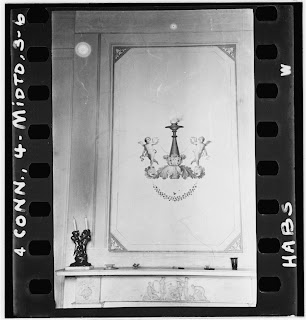 |
| The Richard Alsop IV House, Middletown, CT, 1838-9 Wikimedia |
The Richard Alsop IV house in Middletown is also on High Street and is perhaps unique in the US. This house is often classified as Greek Revival, as found in the book Greek Revival Architecture in America, but it is rather a transitional Greek Revival and Italianate house, as can be seen by its broad eave and brackets. It was designed by the firm of Platt and Benne of New Haven and was built by Barzillai Sage and Isaac Baldwin. The house was bought in 1948 by Wesleyan University from the Alsops; it is currently the Davison Art Center and houses period furniture and a display of prints. It bears some similarity to the nearly contemporary Starr house across the street. The house does not follow the traditional Italianate plan, but it is similar to the symmetrical plan. The central cube has three bays on the front and is flanked by three bayed lower wings with double height squared pillared Doric colonnades. This aspect is particularly Greek Revival in inspiration, as double height porches are not a feature of Italianate. A long cast iron porch runs across the front with a tent roof that is unusually topped by a balcony. The delicate porch features axes with bundles of arrows tied with ribbons on the supports, which are strong Neoclassical design elements.
While the facade is stucco and extremely spare, befitting its very early date, the house has some unusual features. Wooden exterior lambrequins can be found on the first floor windows in the center. It's most unique feature is the painted frescoes on the exterior of the house, which seems to have no other parallels in the US. The frescoes express the entablature of the house with swags and paterae or bowls, another classical motif. On the first floor in the center, and on the centers of the side facades are painted trompe l'oeil frescoes of statue niches, a very fine classical touch that could have been as much an attempt to simulate a Greek house as an Italian Renaissance villa. The second floor on the wings contain trompe l'oeil murals of urns in niches. These are a fascinating example of the use of exterior murals to create rhythm and effect on an otherwise plain surface, and they admirably succeed in enlivening the house. The other colors of the house, pink for the background and cream for the trim are also historically appropriate. The rich mural scheme continues in the interiors, which are filled with beautiful designs that show mostly garden scenes or reproduce Pompeian style decoration. The following images highlight some of the details and show the plan of the house. The frescoes alone make this house a stunning example of transitional design; that they have been well preserved is a credit to Wesleyan.
 |
| Plans from HABS. |

Some Interior views:
The Alsop house sits across the street from the Russell House, one of New England's best Greek Revival homes, which I thought I would include an image of just for fun.











No comments:
Post a Comment